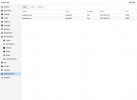Hello,
I would like to enable influx data gathering for ceph. The ceph documentation that I found have instructions on how to enable it, but not how to install it; I can only assume that it installs by default.
However, when I try to enable the influx ceph module in a Proxmox cluster, I get:
Code:
# ceph mgr module enable influx
Error ENOENT: module 'influx' reports that it cannot run on the active manager daemon: influxdb python module not found (pass --force to force enablement)
#
Is there some documentation on how to install the influx ceph module in a manner that Proxmox package updates will behave "nicely" (ie. update the influx module together with the rest of ceph)?
Thanks!
george
I found this, so It seems its enabled and installed from GUI in proxmox there are 2 options see below
External Metric Server

In Proxmox VE, you can define external metric servers, which will periodically receive various stats about your hosts, virtual guests and storages.
Currently supported are:
The external metric server definitions are saved in
/etc/pve/status.cfg, and can be edited through the web interface.
Graphite server configuration

The default port is set to
2003 and the default graphite path is
proxmox.
By default, Proxmox VE sends the data over UDP, so the graphite server has to be configured to accept this. Here the maximum transmission unit (MTU) can be configured for environments not using the standard
1500 MTU.
You can also configure the plugin to use TCP. In order not to block the important pvestatd statistic collection daemon, a timeout is required to cope with network problems.
Influxdb plugin configuration

Proxmox VE sends the data over UDP, so the influxdb server has to be configured for this. The MTU can also be configured here, if necessary.
Here is an example configuration for influxdb (on your influxdb server):
[[udp]]
enabled = true
bind-address = "0.0.0.0:8089"
database = "proxmox"
batch-size = 1000
batch-timeout = "1s"
With this configuration, your server listens on all IP addresses on port 8089, and writes the data in the
proxmox database
Alternatively, the plugin can be configured to use the http(s) API of InfluxDB 2.x. InfluxDB 1.8.x does contain a forwards compatible API endpoint for this v2 API.
To use it, set
influxdbproto to
http or
https (depending on your configuration). By default, Proxmox VE uses the organization
proxmox and the bucket/db
proxmox (They can be set with the configuration
organization and
bucket respectively).
Since InfluxDB’s v2 API is only available with authentication, you have to generate a token that can write into the correct bucket and set it.
In the v2 compatible API of 1.8.x, you can use
user assword
assword as token (if required), and can omit the
organization since that has no meaning in InfluxDB 1.x.
You can also set the HTTP Timeout (default is 1s) with the
timeout setting, as well as the maximum batch size (default 25000000 bytes) with the
max-body-size setting (this corresponds to the InfluxDB setting with the same name).
hope you find this helpful
Kind Regards,
Spiro





